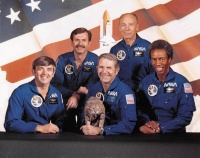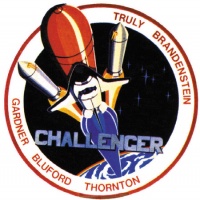STS-8
From The Space Library
 | |
| Organization | NASA-Office of Space Flight (United States) |
|---|---|
| Mission type | Human Crew |
| Launch date | August 30, 1983 |
| Launch vehicle | Space Shuttle |
| Launch site | Cape Canaveral, United States |
| COSPAR ID | 1983-089A |
| Inclination | 28.45 degrees |
| Experiments | Here |
| Alternate Names | 14312 |
| Additional Information | Here |
| Data Collection | Here |
| Payload Mass Up | 13642 kg |
| Payload Mass Down | 10286.82 kg |
| Orbiter | Challenger |
| Lift Off Mass | 2,041,851.82 kg |
| Orbiter Weight at Liftoff | 110,337.27 kg |
| Orbiter Weight at Landing | 92,702.27 kg |
| Landed | Concrete runway 22 at Edwards Air Force Base, Calif. |
| Orbits of Earth | 97 |
| Orbital Altitude | 160 nautical miles (184 statute miles) |
Contents |
Crew
- Commander: Richard H. Truly
- Pilot: Daniel C. Brandenstein
- Mission Specialist 1: Guion S. Bluford Jr.
- Mission Specialist 2: Dale A. Gardner
- Mission Specialist 3: William E. Thornton
Mission
STS 8 was the fourth operational flight of the Space Transportation System. On board were astronauts Richard Truly, Daniel Brandenstein, Dale Gardner, Guion Bluford, and William Thornton. This was the first night launch and landing. Bluford became the first African-American to fly in space. INSAT-1B, a multipurpose satellite for India attached to Payload Assist Module-D (PAM-D) motor, was deployed. The nose of the orbiter was held away from sun for 14 hours to test flight deck area in extreme cold. For Development Flight Instrumentation Pallet (DFI PLT), the crew filmed the performance of an experimental heat pipe mounted in the cargo bay; also, the orbiter dropped to 139 miles altitude to perform tests on thin atomic oxygen to identify the cause of glow that surrounds parts of thr orbiter at night. The remote manipulator system was tested to evaluate joint reactions to higher loads. Biofeedback experiments included: six rats flown in Animal Enclosure Module to observe animal reactions in space. Other payloads included: Continuous Flow Electrophoresis System (CFES); Shuttle Student Involvement Program (SSlP) experiment; Incubator-Cell Attachment Test (l CAT); Investigation of STS Atmospheric Luminosities (ISAL); Radiation Monitoring Equipment (RME); and five Get Away Special experiment packages including eight cans of postal covers. Testing was conducted between the Tracking and Data Relay Satellite-I (TDRS-1 ) and the orbiter using Ku-band antenna, and investigations continued on the Space Adaptation Syndrome. The mission duration was 145 hours 8 minutes 43 seconds.
Payload
Deployment of INSAT (lndia communication satellite) with Payload Assist Module (PAM)-D, Payload Flight Test Article (PFTA)/Payload Deployment Retrieval System (PDRS), Continuous Flow Electrophoresis (CFES), biomedical experiments. 250,000 express mail envelopes with special cachet for U.S. Postal Service were carried for a first-day cover.
Books about the Space Shuttle Program
Buy This Book Click here |
Buy This Book here |
Buy This Book Click here |
Buy This Book Click here |





